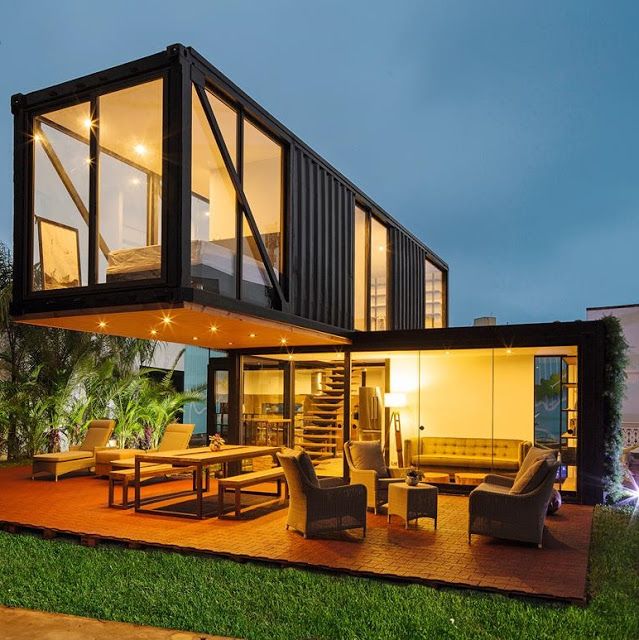Large cities never stop growing – they only grow larger over time. As such, people keep wondering if shipping container homes and tiny homes can pose solutions to this increasing congestion of people in such limited spaces.
While both home types have their advantages, they’re not always applicable in all situations. As such, knowing how to choose one that suits your circumstances is a given.
Shipping Container Homes

What are Shipping Container Homes?
As the name suggests, shipping container homes are homes with repurposed shipping containers as their building materials. These steel crates can become habitable spaces after spending years shipping products.
They are modular and stackable since they are available in conventional sizes, often 20 to 40 feet long. By merging several containers, you can build anything from a straightforward single-container house to a multi-story complex.
Pros of Shipping Container Homes in Urban Areas
Affordability
Container homes are usually cheap. You can buy used containers for as little as $2,000 to $5,000, though prices may increase based on changes.
Container homes provide a cost-effective option for those wishing to own homes in a place with exorbitant housing costs.
Quick to Build
The speed of building is one of the main benefits. You just need to take care of the insulation and interior design because the container doesn’t need construction from the ground up.
Compared to typical brick-and-mortar buildings that can take months or even years, container homes don’t need more than a year to build.
Durability
These steel containers can withstand the harshest maritime conditions. As a result, people trust them as incredibly resilient to the elements and long-lasting.
A shipping container home can survive rather well in an urban setting where buildings can suffer significant wear and tear.
Stackable Design
Containers are perfect for congested urban areas because of their modular design.
They are ideal in megacities with expensive and scarce land because they can be stacked vertically to form multi-story buildings while saving valuable ground space.
Cons of Shipping Container Homes in Urban Areas
Insulation Issues
By itself, steel doesn’t build a comfortable home. You’ll need to add insulation because shipping containers have no inherent insulation features to keep your house comfortable in both hot and cold weather.
Making a container home habitable may become more expensive and time-consuming as a result.
Zoning and Aesthetic Concerns
Unfortunately, not all cities are on board with the idea of container homes. Certain neighborhoods may object to the industrial appearance of containers, and zoning regulations in some places may prohibit this kind of development.
Here, you might need to learn local regulations on container homes and find some legal experts just to get your project approved.
Toxic Materials
Even after careful cleaning, hazardous residue may still be present in some containers with previous use to transport chemicals.
Make sure a container hasn’t been exposed to any dangerous materials before converting it into a home.
Tiny Homes

What are Tiny Homes?
Tiny homes usually range in size from 100 to 400 square feet. They come in these sizes to make them as efficient as possible and frequently have ingenious space-saving elements like multipurpose rooms or foldable furniture.
Furthermore, tiny homes are transportable and can be set up on wheels or built on a base.
Pros of Tiny Homes in Urban Areas
Minimalist Living
In a busy, fast-paced urban setting, the minimalist lifestyle that tiny homes promote can be alluring for people living in such a place.
Living in a tiny house makes you concentrate on the necessities, reducing unnecessary items and simplifying your life.
Sustainable and Energy-Efficient
Tiny homes use less energy to heat and cool and less material to construct due to their compact size. They are therefore a fantastic choice for people who care about the environment and wish to lessen their carbon footprint.
Tiny homes can lessen the environmental burden in a congested metropolis where sustainability is becoming more and more significant.
Design Flexibility
You can modify tiny homes to your liking to meet your needs and come in a variety of designs and styles. You can purchase a prefabricated model or construct one from the ground up.
Additionally, if it is wheeled, you can move with it if you so choose.
Affordability
Tiny homes, similar to shipping container homes, provide a more cost-effective alternative in cities where conventional residences are pricey.
Though pricing might vary depending on materials and customization, they typically cost between $10,000 and $50,000.
Cons of Tiny Homes in Urban Areas
Zoning Challenges
Zoning regulations in many places make it challenging to locate tiny homes in urban areas since tiny homes don’t meet the minimum size requirements set by several cities.
Finding a permitted spot to park a small home can be difficult in places where they are permitted, particularly if they are mobile homes.
Limited Space
You can only do so much in 100 to 400 square feet, even if tiny homes are intended to maximize their modest space.
This might be sufficient space for a single person or a couple, but families or those who work from home may find it difficult to use. You may feel a little claustrophobic in a megacity when room is already scarce.
Permanent vs. Mobile
Your tiny house becomes a permanent building if you build it on a foundation, thus you will need to own the property it is situated on. This can raise the total cost considerably in a city with exorbitant land prices.
Finding a parking space that is permitted will be difficult, though, if your tiny house is mobile and is on wheels.
Which Is Better for Crowded Urban Living?
Space Efficiency
Compared to tiny homes, shipping container residences usually offer more space. Approximately 320 square feet can be found in a 40-foot container, and larger living spaces can be created by combining several containers.
Conversely, tiny residences often have a maximum size of 400 square feet. Container homes could be a better choice if you need extra space, especially if you have a family.
Cost
Tiny homes and shipping container homes are both reasonably priced substitutes for conventional homes; although, the latter may require additional expenditures for insulation and customization.
Although tiny homes, especially pre-built models, can be less expensive initially, you will need to think about where to put them, especially in cities where land is more expensive.
Aesthetic Appeal
Tiny homes can be designed in a wide range of styles, from rustic cabins to sleek modern spaces, while shipping container homes have a more industrial look.
If you’re in a neighborhood with strict aesthetic guidelines, you might run into more resistance with a container home. Contrarily, tiny homes might blend in more easily with traditional architecture.
Environmental Impact
Both options have potential environmental benefits, where tiny homes are generally more sustainable because they require fewer materials and less energy.
At the same time, shipping container homes recycle existing materials, giving new life to old containers. As such, it’s a toss-up depending on how the homes are built and maintained.
Conclusions
Between container homes and tiny homes, having a full comprehension of your home needs is all you need to make the most ideal choice. If you eventually choose to build a container home, then choose no other vendor than Tradecorp as your shipping container provider. With over 35 years of trusted experience in the industry, Tradecorp can fulfill all your container home needs by providing the one you’ll need.

